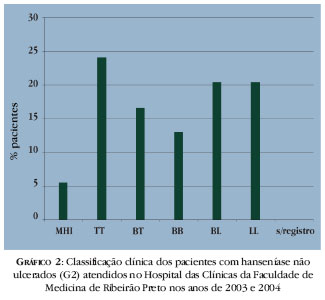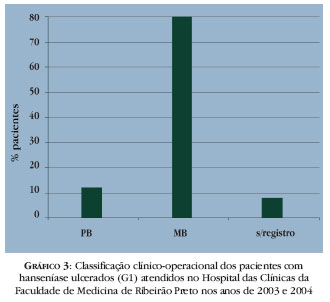BACKGROUND: Leprosy is a chronic disease and its complications include neural lesions, which may cause motor and sensitive changes, leading to deformities as well as skin ulcers. OBJECTIVE: To show the epidemiological profile of leprosy patients with ulcerated and non-ulcerated lesions, seen at the Hospital das Clínicas de Ribeirão Preto. METHODS: A cross-section study of the medical charts of 79 leprosy patients seen at the hospital in 2003/2004. Patients were classified into Group 1 (ulcerated lesions) and Group 2 (non-ulcerated lesions) based on their clinical and epidemiological characteristics. RESULTS: In this sample, 69.6% were male, 91.1% white and positive bacilli were found in 62%. Among them, 25 (32%) presented skin ulcers (Group 1) located on the lower limbs in 68% of cases, classified as disability grade II (72%), as compared to group 2 (p<0.01). Based on spectral leprosy classification, there were differences between tuberculoid and lepromatous (p<0.01), borderline and borderline lepromatous (p<0.05) and between the latter one and lepromatous form (p<0.01). As to the operational classification, 80% of patients with ulcers were multibacillary and 12% were paucibacillary (p<0.05). CONCLUSION: Groups 1 and 2 were epidemiologically similar. The ulcerated skin lesions seem to be related to disability grade II and to positive bacilli detected by both spectral and operational classifications.
Abnormalities; Leprosy; Skin ulcer






